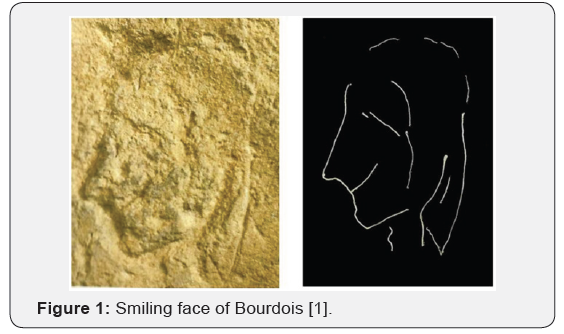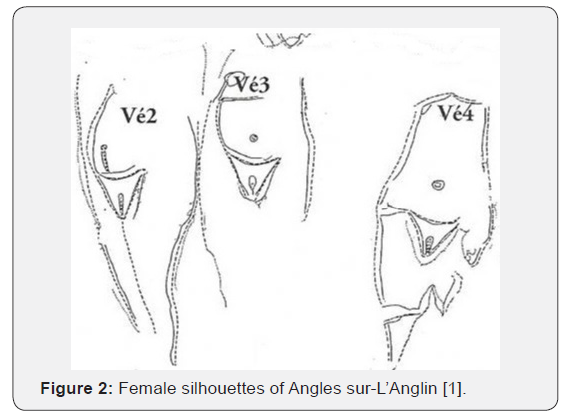Archaeology & Anthropology - Juniper Publishers
Summary
From a graphic point of view, smiles are prior to
tears. While the smiles are documented in human graffiti from the
Paleolithic period (Middle Magdalenian), tears are documented much
later, in animals of post paleolithic periods. These data help us to
make a few reflections about our way of seeing art, which may be
influenced by our culture, too serious, for a few graphs that are not so
much.
Keywords: Smile; Laughter; Paleolithic art; Evolution
The smile of Bourdois
The figure reproduced below is a cave engraving of
the Bourdois shelter, located in the Vienne, France. They will agree
with me that at first glance it does not seem to have anything of
particular. It is a small human face endowed, of course, with a broad
smile [1]. But, if we consider that the spelling in question is 15,000
years old, the thing changes, and the impression that the smile produces
increases. Indeed, we are facing one of the first smiles in the History
of Art. The smile of Bourdois is not, far from it, as famous as that of
the Mona Lisa, and yet its transcendence is much greater. Even if only
because a smile from 15,000 years ago contains many more puzzles than
one of just four centuries. And if not, look closely at the face, is it
possible to look at this smiling face for a long time without smiling?
This reaction, almost instinctive, says a lot about the human species,
about who we are and why we are here (Figure 1).

This enigmatic fascination, which all attentive
observers share, is caused by the intimacy of a gesture of different and
partly undefined nuances. And is that every smile always harbors a
suspicion: the shadow of dissimulation. You can see in it the trace of
deceit, submission or fear. But, although the shadow
of a doubt looms over its inner light, the smile is, above all, an
expression of pleasure and happiness. For a smile manages to stay true
to itself and its own mystery. That is to say, what really hides is,
neither more nor less, than the secret of happiness.
On the other hand, the fascinating attraction that a
smile exerts can be understood as a power of seduction that, Freud did
not hesitate to describe as erotic [2]. And although the genius of
psychoanalysis was too often carried away by interpretations of a sexual
nature, it is quite possible that this time it was not misguided.
Almost all the specialists in gestural mimicry agree in affirming that
the smile has an erotic function. Even scholars of human behavior have
highlighted the erotic relationship of
the smile in current primitive peoples [3]. This relationship may be
very old, perhaps prehistoric. In paleolithic art we have four examples
in which the smile is associated with anthropomorphic figures with
upright sex [4]. These spellings seem to reflect a relationship between
happiness and sexual satisfaction.
The female silhouettes of Angles-sur-l’Anglin
A few meters from the smiling face of Bourdois we
have, in the same frieze, four sculpted female silhouettes, in a
position that today we would not hesitate to describe as erotic. So much
so, that Guthrie has compared these paleolithic profiles with the
images of the Playboy. The comparison with current pornography deserves
to be criticized at least in two essential points. The first is that
porn is characterized by its seriousness, it is, in the words of
Braudillard, deadly serious [5]. Which means that there has been a
process of verification of the erotic in the pornographic, or, to put it
another way, the vital and joyful component of the erotic has been
eliminated, turning it into something mechanical and artificial, reduced
to an act highly stereotyped And secondly, the pornographic in Western
culture excludes the sacred, something that does not happen for example
in the East.
However, as can be seen in three of the graphs reproduced
below, the silhouettes of Angles-sur-l’Anglin, have an inescapable
erotic tone. The pose of naked bodies has a disconcerting effect.
It is almost impossible not to see in them the bodies of contemporary
models or sex symbols. What does not lead us to ask
the following question, what we see is conditioned by our pornographic
aesthetics or does it have some biological basis? Look
at the sinuous lines that frame the vulvas and delineate the hips
and part of the legs. These parts of the female body are erotic in
virtually all human cultures [6].
The reason why aesthetics uses these forms has a biological basis, that is, a “practical” sense. It is no coincidence that the beauty ideals of a tribe of Trobians and Westerners are so similar [7]. Nor that, apparently, these ideals, based on body proportions, have not changed over time. Well, they respond to a purpose, which is to stimulate reproduction, because according to certain studies, female hips and legs without visual indicators of women’s fertility. Furthermore, not only the silhouettes of Angles-sur-l’Anglin have that disconcertingly modern character; but there are other similar examples in the caves of Le Gabillou and La Magdeleine. The position of these female bodies, reminiscent of Goya’s Nude Maja, is eminently erotic. For example, the position of the arm behind the head in the bas-reliefs of La Magdeleine, is an expression of enjoyment that is also observed in sexual scenes from Roman times. In a painting of the House of the Restaurant of Pompeii (1st century), A woman bends her arm in this way while practicing sex with a man. The scene, of obvious interpretation in the Roman case, is not in the prehistoric. What is evoked in Paleolithic art is not the act itself, but something more complex whose final meaning escapes us. But what is interesting here is to point out that artists or paleolithic artists are the creators of a visual eroticism that is surely different from what we understand today. It was probably a happy and perhaps sacred eroticism, but the result of the complex world of seduction, the mystery of attraction, of creation and of life (Figure 2).
The reason why aesthetics uses these forms has a biological basis, that is, a “practical” sense. It is no coincidence that the beauty ideals of a tribe of Trobians and Westerners are so similar [7]. Nor that, apparently, these ideals, based on body proportions, have not changed over time. Well, they respond to a purpose, which is to stimulate reproduction, because according to certain studies, female hips and legs without visual indicators of women’s fertility. Furthermore, not only the silhouettes of Angles-sur-l’Anglin have that disconcertingly modern character; but there are other similar examples in the caves of Le Gabillou and La Magdeleine. The position of these female bodies, reminiscent of Goya’s Nude Maja, is eminently erotic. For example, the position of the arm behind the head in the bas-reliefs of La Magdeleine, is an expression of enjoyment that is also observed in sexual scenes from Roman times. In a painting of the House of the Restaurant of Pompeii (1st century), A woman bends her arm in this way while practicing sex with a man. The scene, of obvious interpretation in the Roman case, is not in the prehistoric. What is evoked in Paleolithic art is not the act itself, but something more complex whose final meaning escapes us. But what is interesting here is to point out that artists or paleolithic artists are the creators of a visual eroticism that is surely different from what we understand today. It was probably a happy and perhaps sacred eroticism, but the result of the complex world of seduction, the mystery of attraction, of creation and of life (Figure 2).

Prehistoric eroticism, and its Paleolithic graphic expression, have their roots in human evolution. Specifically, in the development of our particular mode of sexual reproduction. About two million years ago, our hominid relatives began a strategy of reproduction that we could describe as optimistic, since it consisted, mainly, of having sex a more or less constant pleasure. This fact was crucial in the evolution of our species. Our reproductive success (it is estimated that we are around 7,000 million people in the world) is unparalleled in the history of placental mammals. If we are a prolific species par excellence it is thanks to the intrinsic quality of our sex to provide us with pleasure at any time of the year. The other animal species either do not experience as much pleasure or are subject to short periods of heat. Human sexuality does not depend, like that of other mammals, on the olfactory stimuli and the hormonal chemistry of pheromones; but predominantly visual stimuli, based mainly on physical features and body proportions [7]. This explains, to a certain extent, the eroticism of artistic expressions. Today the pornographic market has reduced the erotic to its minimal expression. The most visited websites on the internet are, by far, pornographic. We are a species that we bet on the pleasure of reproduction. And natural selection has favored this optimistic strategy.
The Tears
From a graphic point of view, smiles are prior to tears. The
tears that appear on the faces of the Tassili cows, studied by Le
Quellec [8], seem to have a symbolic meaning. We have to go
back to the Egyptian period (2000 BC) to identify the tears, not
in a human, but in a cow again, which apparently cries because
they are going to sacrifice their bull in a relief of a sarcophagus
of Deir el- Bahari Are human feelings attributed or is it that these
feelings are not exclusively human? Are historical cultures more
pessimistic than prehistoric ones? About four million years ago,
the Mesopotamian civilization left us a magnificent example of
the existential pessimism that has developed in our culture in a
way surreptitious as a principle of unquestionable reality. Since
then, pessimism has slowly imposed itself, making us believe
that the human species is sinful by nature. That’s what researchers
think of the human imagination as Beltrán [9]. And it is that
the real, in our world, is the serious thing, that is, the drama of
life. In other words, more Freudian, our principle of reality is occupied
by the drama of the serious. This is an automatism that
operates mechanically in our culture without hardly questioning.
However, is optimism defining us as a species? The instinct
of reproduction is the means by which the organic announces
the joy of existence. Therefore, what we call optimism is the
force that animates existence and drives reproduction. We can
appreciate the laughter in the animals, the song of the birds, the
tail of the dog, the purring of the cats. Is the joy of existence the
engine of evolution? From this point of view, the upright position
of the sapiens animals, allows the face to be seen, which is fundamental
in the non-verbal communication of the smile. And besides,
the bipedal position exposes the sexual organs, “shames”
that all human cultures cover in some way. Shame is one of the
fundamental axes of laughter. This feeling has played an important
role in the development of human humor, in, for example, the
phallic exhibitions.
To Know more about Archaeology & Anthropology
Click here: https://juniperpublishers.com/gjaa/index.php
To Know more about our Juniper Publishers
Click here: https://juniperpublishers.com/index.php
Click here: https://juniperpublishers.com/gjaa/index.php
To Know more about our Juniper Publishers
Click here: https://juniperpublishers.com/index.php





No comments:
Post a Comment